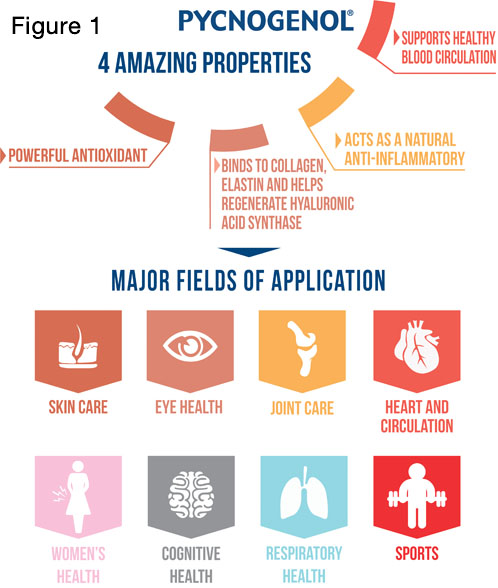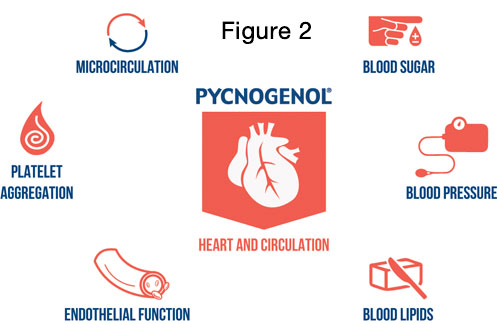First and foremost, Pycnogenol stands apart from single compounds; it’s a naturally programmed combination with constant proportions of procyanidins, bioflavonoids and organic acids.
Pycnogenol French maritime pine bark extract’s unique blend of active compounds cannot be found in any other plant extract. Each of its compounds provides a different way of acting in the body.
Some of the larger molecules get further processed in the gut into metabolites. Remarkably, these metabolites are also absorbed into our bloodstream, contributing to Pycnogenol’s overall efficacy.
Consequently, Pycnogenol offers a comprehensive array of active compounds, distinguishing it from single-component alternatives.
The key properties of Pycnogenol on the body are its powerful antioxidant actions, its natural anti-inflammatory benefits, its effects on the skin and tissues and its support for blood circulation (Figure 1).1,2,9–31

Collectively, these mechanisms account for the extensive range of applications that Pycnogenol holds in the realms of health and beauty. Ongoing research will continue to unveil further insights and potentially discover additional applications for the effects of Pycnogenol.
Pycnogenol improves blood circulation
Keeping the cardiovascular system healthy is key to maintaining good vitality, physical strength, mental health and for general well-being. Blood vessels bring oxygen and nutrients through arteries and the tiniest microvessels all over our body, providing beneficial effects from head to toe.
Pycnogenol exerts some of its beneficial effects as it optimises blood flow by improving endothelial function (see Figure 2). Blood flow regulation involves maintaining an appropriate distribution of blood throughout the body to meet the metabolic demands of tissues and organs.
All blood vessels in the cardiovascular system are lined with the so-called endothelium; this is a single layer of cells lining the inner surface of blood vessels (including arteries and veins).
This layer not only serves as a simple delimitation of the vessel wall but is also significantly involved in many physiological functions, such as controlling blood pressure by vasoconstriction and dilation, regulating the exchange of substances between blood and tissues, preventing blood clotting and signalling during inflammation.
Endothelial function and blood flow regulation are crucial for overall health.
Many different studies have shown that Pycnogenol has a positive effect on blood circulation and microcirculation by improving endothelial function and by lowering platelet aggregation without increasing bleeding time.1,5,21–35
In addition, Pycnogenol has been shown to normalize blood pressure and to improve blood lipid profile as well as blood sugar values.10,11,13,23,24,36–41

Interestingly, it was found that a metabolite of Pycnogenol can be taken up in endothelial cells and can thus exert its anti-inflammatory effects directly in the endothelium.22
Pycnogenol for the endothelium
Numerous studies have consistently shown that Pycnogenol improves endothelial function, resulting in a positive impact on both blood circulation and microcirculation, firmly establishing its effectiveness.
In patients with coronary artery disease, the effect of Pycnogenol on endothelial function was investigated by assessing “flow-mediated dilation” in the upper arm artery.1
For this method, the expansion of the artery in response to an increase in the shear stress associated with blood flow is measured.
An 8-week randomised, placebo-controlled, crossover, double-blind study showed an improvement in flow-mediated dilation of 32% in the Pycnogenol group, whereas it deteriorated slightly in the placebo patients.
In another study, the flow-mediated dilation of patients with borderline high blood pressure, high blood lipid levels and increased blood sugar levels improved significantly after 8 and 12 weeks of Pycnogenol intake.25
These studies, among several others, confirm the positive effects of taking Pycnogenol on endothelial function in patients with cardiovascular diseases.
References
- F. Enseleit, et al., “Effects of Pycnogenol on Endothelial Function in Patients With Stable Coronary Artery Disease: A Double-Blind, Randomized, Placebo-Controlled, Cross-Over Study,” Eur. Heart J. 33(13),1589–1597 (2012).
- J. Ryan, et al., “An Examination of the Effects of the Antioxidant Pycnogenol on Cognitive Performance, Serum Lipid Profile, Endocrinological and Oxidative Stress Biomarkers in an Elderly Population,” J. Psychopharmacol. 22(5), 553–562 (2008).
- A-S. Weyns, et al., “Clinical Investigation of French Maritime Pine Bark Extract on Attention-Deficit Hyperactivity Disorder as Compared to Methylphenidate and Placebo: Part 1: Efficacy in a Randomised Trial,” Journal of Functional Foods 97, 105246 (2022).
- D. Wilson, et al., “A Randomized, Double-Blind, Placebo-Controlled Exploratory Study to Evaluate the Potential of Pycnogenol for Improving Allergic Rhinitis Symptoms,” Phytother. Res. 24(8), 1115–1119 (2010).
- R. Steigerwalt, et al., “Pycnogenol Improves Microcirculation, Retinal Edema, and Visual Acuity in Early Diabetic Retinopathy,” J. Ocul. Pharmacol. Ther. 25(6), 537–450 (2009).
- H. Zhao, et al., “Oral Pycnogenol Intake Benefits the Skin in Urban Chinese Outdoor Workers: A Randomized, Placebo-Controlled, Double-Blind and Crossover Intervention Study,” Skin Pharmacol. Physiol. 34(3), 135–145 (2021).
- H. Maia, Jr, C. Haddad and J. Casoy, “The Effect of Pycnogenol on Patients with Dysmenorrhea Using Low-Dose Oral Contraceptives,” Int. J. Womens Health 6, 1019–1022 (2014).
- T. Kohama and M. Negami, “Effect of Low-Dose French Maritime Pine Bark Extract on Climacteric Syndrome in 170 Perimenopausal Women: A Randomized, Double-Blind, Placebo-Controlled Trial,” J. Reprod. Med. 58(1–2), 39–46 (2013).
- Z. Chovanova, et al., “Effect of Polyphenolic Extract, Pycnogenol, on the Level of 8-Oxoguanine in Children Suffering From Attention Deficit/Hyperactivity Disorder,” Free Radic. Res. 40(9), 1003–1010 (2006).
- Z. D̆uračková, et al., “Lipid Metabolism and Erectile Function Improvement by Pycnogenol Extract From the Bark of Pinus pinaster in Patients Suffering From Erectile Dysfunction: A Pilot Study,” Nutrition Research23(9), 1189–1198 (2003).
- S. Devaraj, et al., “Supplementation with a Pine Bark Extract Rich in Polyphenols Increases Plasma Antioxidant Capacity and Alters Plasma Lipoprotein Profile,” Lipids 37(10), 931–934 (2002).
- M. Kolacek, et al., “Effect of Natural Polyphenols (Pycnogenol) on Oxidative Stress Markers in Children Suffering From Crohn’s Disease: A Pilot Study,” Free Radic. Res. 47(8), 624–634 (2013).
- H.M. Yang, et al., “A Randomised, Double-Blind, Placebo-Controlled Trial on the Effect of Pycnogenol on the Climacteric Syndrome in Peri-Menopausal Women,” Acta Obstet. Gynecol. Scand. 86(8), 978–985 (2007).
- S. Errichi, et al., “Supplementation with Pycnogenol Improves Signs and Symptoms of Menopausal Transition,” Panminerva Med. 53(3), 65–70 (2011).
- R. Canali, et al., “The Anti-Inflammatory Pharmacology of Pycnogenol in Humans Involves COX-2 and 5-LOX mRNA Expression in Leukocytes,” Int. Immunopharmacol. 9(10), 1145–1149 (2009).
- T. Grimm, et al., “Inhibition of NF-kappaB activation and MMP-9 Secretion by Plasma of Human Volunteers After Ingestion of Maritime Pine Bark Extract (Pycnogenol),” J. Inflamm. (Lond.) 3 1 (2006): PMC1413525.
- A. Schäfer, et al., “Inhibition of COX-1 and COX-2 Activity by Plasma of Human Volunteers After Ingestion of French Maritime Pine Bark Extract (Pycnogenol),” Biomed. Pharmacother. 60(1), 5–9 (2005).
- A. Marini, et al., “Pycnogenol Effects on Skin Elasticity and Hydration Coincide with Increased Gene Expressions of Collagen Type I and Hyaluronic Acid Synthase in Women,” Skin Pharmacol. Physiol. 25(2), 86–92 (2012).
- T. Grimm, A. Schäfer and P. Högger, “Antioxidant Activity and Inhibition of Matrix Metalloproteinases by Metabolites of Maritime Pine Bark Extract (Pycnogenol),” Free Radic. Biol. Med. 36(6), 811–822 (2004).
- D.F. Fitzpatrick, B. Bing and P. Rohdewald, “Endothelium-Dependent Vascular Effects of Pycnogenol,” J. Cardiovasc. Pharmacol. 32(4), 509–515 (1998).
- K. Nishioka, et al., “Pycnogenol, French Maritime Pine Bark Extract, Augments Endothelium-Dependent Vasodilation in Humans,” Hypertens. Res. 30(9), 775–780 (2007).
- K. Uhlenhut and P. Högger, “Facilitated Cellular Uptake and Suppression of Inducible Nitric Oxide Synthase by a Metabolite of Maritime Pine Bark Extract (Pycnogenol),” Free Radic. Biol. Med. 53(2), 305–313 (2012).
- X. Liu, et al., “Pycnogenol, French Maritime Pine Bark Extract, Improves Endothelial Function of Hypertensive Patients,” Life Sci. 74(7), 855–862 (2004).
- S. Zibadi, et al., “Reduction of Cardiovascular Risk Factors in Subjects with Type 2 Diabetes by Pycnogenol Supplementation,” Nutr. Res. 28(5), 315–320 (2008).
- S. Hu, et al., “Effects of Pycnogenol on Endothelial Dysfunction in Borderline Hypertensive, Hyperlipidemic and Hyperglycemic Individuals: The Borderline Study,” Int. Angiol. 34(1), 43–52 (2015).
- G. Belcaro, et al., “Diabetic Ulcers: Microcirculatory Improvement and Faster Healing with Pycnogenol,” Clin. Appl. Thromb. Hemost. 12(3), 318–323 (2006).
- G. Belcaro, et al., “Venous Ulcers: Microcirculatory Improvement and Faster Healing with Local Use of Pycnogenol,” Angiology 56(6), 699–705 (2005).
- M.R. Cesarone, et al., “Improvement of Diabetic Microangiopathy with Pycnogenol: A Prospective, Controlled Study,” Angiology 57(4), 431–436 (2006).
- S. Wang, et al., “The Effect of Pycnogenol on the Microcirculation, Platelet Function and Ischaemic Myocardium in Patients with Coronary Artery Diseases,” European Bulletin of Drug Research 7(2), 19–25 (1999).
- M. Araghi-Niknam, et al., “Pine Bark Extract Reduces Platelet Aggregation,” Integrative Medicine 2(2), 73–77 (2000).
- M. Pütter, et al., “Inhibition of Smoking-Induced Platelet Aggregation by Aspirin and Pycnogenol,” Thrombosis Research 55, 155–161 (1999).
- C. Cai, et al., “An Oral French Maritime Pine Bark Extract Improves Hair Density in Menopausal Women: A Randomized, Placebo‐Controlled, Double Blind Intervention Study,” Health Science Reports 6(1): e1045(2023).
- M.R. Cesarone, et al., “Chronic Venous Insufficiency and Venous Microangiopathy: Management with Compression and Pycnogenol,” Minerva Cardioangiol. 67(4), 280–287 (2019).
- R. Luzzi, et al., “Improvement in Symptoms and Cochlear Flow with Pycnogenol in Patients with Meniere’s Disease and Tinnitus,” Minerva Med. 105, 245–254 (2014).
- M.G. Grossi, et al., “Improvement in Cochlear Flow with Pycnogenol in Patients with Tinnitus: A Pilot Evaluation,” Panminerva Med. 52(2), 63–67 (2010).
- S. Hosseini, et al., “A Randomized, Double-Blind, Placebo-Controlled, Prospective, 16-Week Crossover Study to Determine the Role of Pycnogenol in Modifying Blood Pressure in Mildly Hypertensive Patients,” Nutr. Res. 21(9), 1251–1260 (2001).
- S.B.G. Stuard, et al., “Kidney Function in Metabolic Syndrome May Be Improved With Pycnogenol,” Panminerva Med. 52(2), 27–32 (2010).
- A. Schäfer and P. Högger, “Oligomeric Procyanidins of French Maritime Pine Bark Extract (Pycnogenol) Effectively Inhibit Alpha-Glucosidase,” Diabetes Res. Clin. Pract. 77(1), 41–46 (2007).
- R. Koch, “Comparative Study of Venostasin and Pycnogenol in Chronic Venous Insufficiency,” Phytother. Res. 16(Suppl. 1), S1–S5 (2002).
- B. Trebaticky, et al., “Natural Polyphenols Improve Erectile Function and Lipid Profile in Patients Suffering From Erectile Dysfunction,” Bratisl. Med. J. 120(12), 941–944 (2019).
- G. Belcaro, et al., “Pycnogenol Supplementation Improves Health Risk Factors in Subjects with Metabolic Syndrome,” Phytother. Res. 27(10), 1572–1578 (2013).
